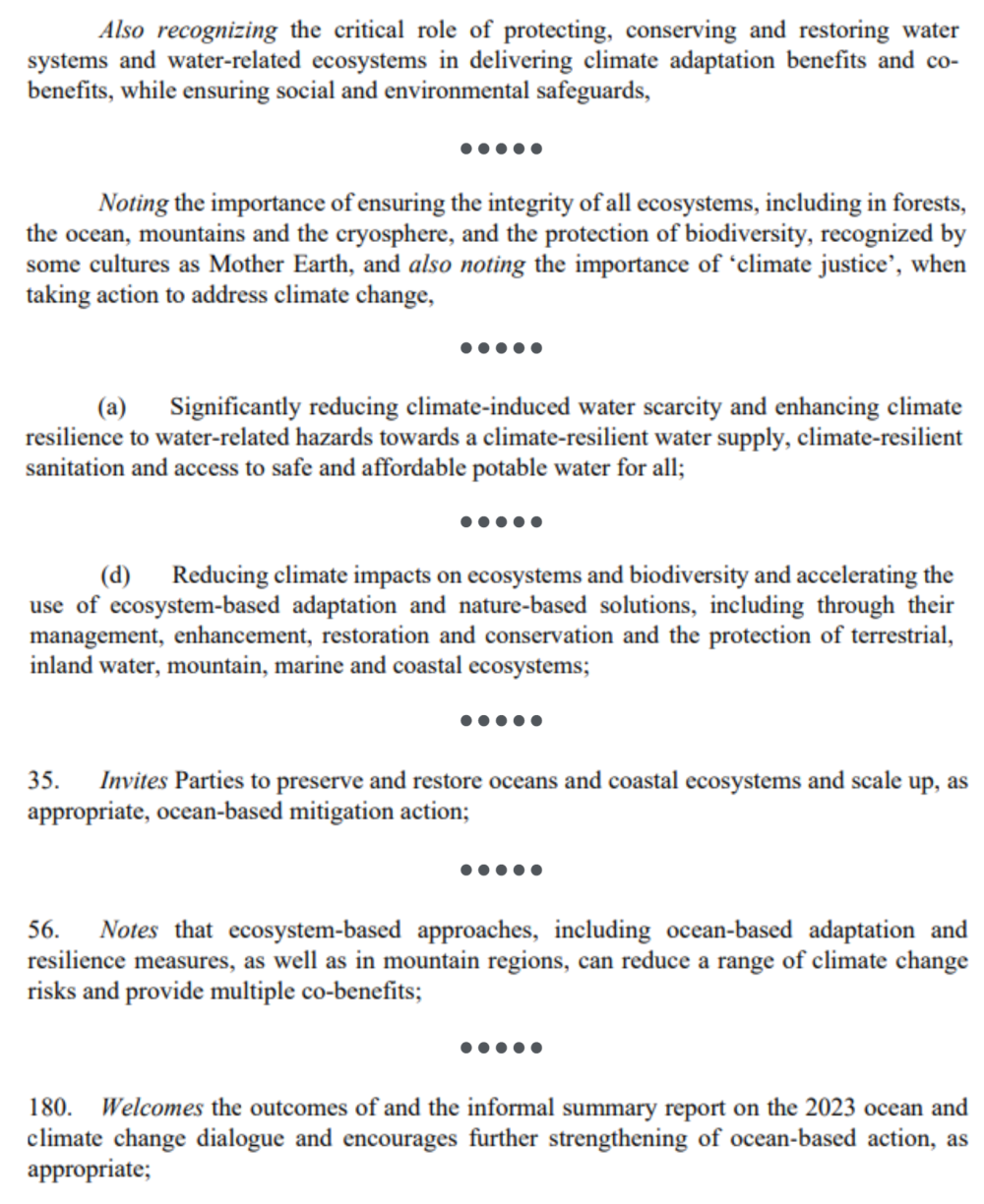COP28 – What does it mean for water?
COP28 took place between 30 November and 12 December, in Dubai, United Arab Emirates. Our Affiliated Researcher, Paulina Raniecka, is taking a look at the content of the conference and its final output – the Global Stocktake, unraveling the role of water.
Following the promise of the previous COP, water remained a prominent feature of the agenda for the Dubai climate summit. Similar to the statement by Csaba Kőrösi, the previous President of the United Nations General Assembly, who declared COP27 as ‘the water COP’, the UAE presidency made their promises to ‘drive water up the climate agenda’ (Hayden, 2023; UN 2022). Water appeared as one of the key themes in the COP28 program – 9 December was the thematic day for nature, land use, and oceans, while 10 December centered around food, agriculture, and water.
Overall, there were over 150 sessions on water-related issues (Karlsson, 2023). The Water for Climate Pavilion gathered over 60 organizations, the highest number so far. The Summit hosted a special water session featuring several heads of state and multilateral development banks. The COP28 program offered a great variety within the water events, including those led by youth, Indigenous organizations and more. Water took a truly central role and the related discussions proved to be rich in content, multi-faceted and synergistic in establishing a clear link between water and other topics of the COP (e.g., the “Water IS the Climate Challenge” session), and pragmatic in introducing specific solutions and contributions to climate change mitigation and adaptation (e.g., “Water – Hydrating Climate Action”). However, this abundance of water information appears to be rather diluted when looking at the global stocktake document produced at the COP.
As depicted in an anecdote shared by Alexander Reyes-Knoche of IWA, one of the very first interactions he had during the previous climate summit started with the following question from a delegate: “But then, if you are a water professional, what are you doing here at this climate change conference?” (Reyes-Knoche, 2022, n.p.). This portrays the siloed approach to the environmental crisis, which is mirrored in the COP28 outputs and coverage. Fossil fuel phase out (or rather “transitioning away”, as the final version of the text puts it) is dominating the COP28 discourse.
One might argue that there is danger in taking this reductionist approach to tackling climate change. Focusing almost exclusively on fossil fuel emissions risks neglecting other areas of the environmental crisis. Despite the unequivocally central role of greenhouse gases in driving the climate crisis, the consequences are “inherently liquid” (Hayden, 2023, n.p.; Schabus, 2023). Water is one of the key underlying themes of the ongoing crisis, with floods ravaging areas including northern Australia, Tamil Nadu province of India, parts of Sandakan in Malaysia, and both the East and West Coast of the US at the time of writing this piece.
The term water crisis is not a novelty. The urgency of the water situation started gaining attention from around 1982 onwards. However, it was only in the 1990s (particularly by the mid-90s) when the idea of the water crisis became accepted as a phenomenon looming in the near future (Biswas, 1999). Water crisis can manifest itself in various different ways. Most commonly it is reported as a set of quantity and quality issues, however, a plethora of water problems can be classified under this term (Srinivasan et al., 2012). What further complicates the picture is the fact that many water challenges are a type of ‘wicked’ problems – complex, interconnected, and unable to be solved through the use of conventional measures (Markowska et al., 2020; Rittel & Weber, 1973).
This complexity and inherent interconnectedness calls for synergistic and holistic approaches that apply a wider lens to understand the linkages and feedbacks within a given system. This assumption appears to be reflected in the Global Stocktake, arguing for the “integrity of all ecosystems” (p. 2), the “urgent need to address, in a comprehensive and synergetic manner, the interlinked global crises of climate change and biodiversity loss” (p. 2), and the “implementation of integrated, multi-sectoral solutions” (p. 8) amongst other claims.
However, when looking specifically for water in the Global Stocktake, its presence is not as abundant as the COP28 program would suggest. The following extracts mention water resources:
The list of water-related points from the Global Stocktake.
Little attention has been paid to concrete steps that would allow us to arrive at these suggested steps. What is more, as the UAE is receiving (well-deserved) praise over their Declaration on Sustainable Agriculture, Resilient Food Systems, and Climate Action, one cannot fail to notice the glaring lack of a declaration on water; particularly when seeing other COP28 UAE declarations ranging from climate and health, through gender-responsive just transitions, to global climate finance network.
Another aspect worth discussing is the difference in the focus on mitigation and adaptation measures. As shown by Praveena Sridhar in her post-COP reflection, the climate financing ratio stands at around 1 to 10. This inclination towards adaptation is seen in nearly all of the water claims in the Global Stocktake (apart from the recognition of ocean-based mitigation measures). However, when it comes to freshwater resources, the text paints water as central solely in adaptation. Now, to bring back Sridhar’s piece, “semantics matter”. Such portrayal disregards the powerful role freshwater can play in mitigating the climate crisis, as shown in SIWI’s 2022 report.
Seeing water established as one of the central themes for both COP27 and COP28 is irrefutably a positive trend. Similarly, the richness of the water-centered sessions during the recent Climate Summit suggests a hopeful way forward for the role of water on the global political agenda. Nonetheless, the final output of the COP leaves us wanting more. The big question is: “can we get it anytime soon?”
References:
Biswas, A. K. (1999). Water Crisis: Current Perceptions and Future Realities. Water International, 24(4), pp. 363-367. https://doi-org.vu-nl.idm.oclc.org/10.1080/02508069908692189
Hayden, N. (30 November, 2023). Water is a high-level priority at COP 28, we need to look to ground-level users for solutions. Retrieved from: https://blogs.edf.org/growingreturns/2023/11/30/water-is-a-high-level-priority-at-cop-28-we-need-to-look-to-ground-level-users-for-solutions/
Karlsson, A. (12 December, 2023). Closing COP28: important strides for water. Retrieved from: https://siwi.org/latest/closing-cop28-important-strides-for-water/
Markowska, J., Szalińska, W., Dąbrowska, J., & Brząkała, M. (2020). The concept of a participatory approach to water management on a reservoir in response to wicked problems. Journal of Environmental Management, 259. https://doi.org/10.1016/j.jenvman.2019.109626
Reyes-Knoche, A. (13 January, 2022). COP 27: impressions, results and the importance of water. Retrieved from: https://iwa-network.org/cop-27-impressions-results-and-the-importance-of-water/
Rittel, H. W. J., & Webber, M. M. (1973). Dilemmas in a General Theory of Planning. Policy Sciences, 4, pp. 155-169.
Sridhar, P. (14 December, 2023). Comment: The final COP28 text misses one crucial word - soil. Retrieved from: https://www.reuters.com/sustainability/land-use-biodiversity/comment-final-cop28-text-misses-one-crucial-word-soil-2023-12-14/
Srinivasan, V., Seto, K. C., Emerson, R., & Gorelick, S. M. (2013). The impact of urbanization on water vulnerability: A coupled human-environment system approach for Chennai, India. Global Environmental Change, 23(1), pp. 229–239. https://doi.org/10.1016/j.gloenvcha.2012.10.002





